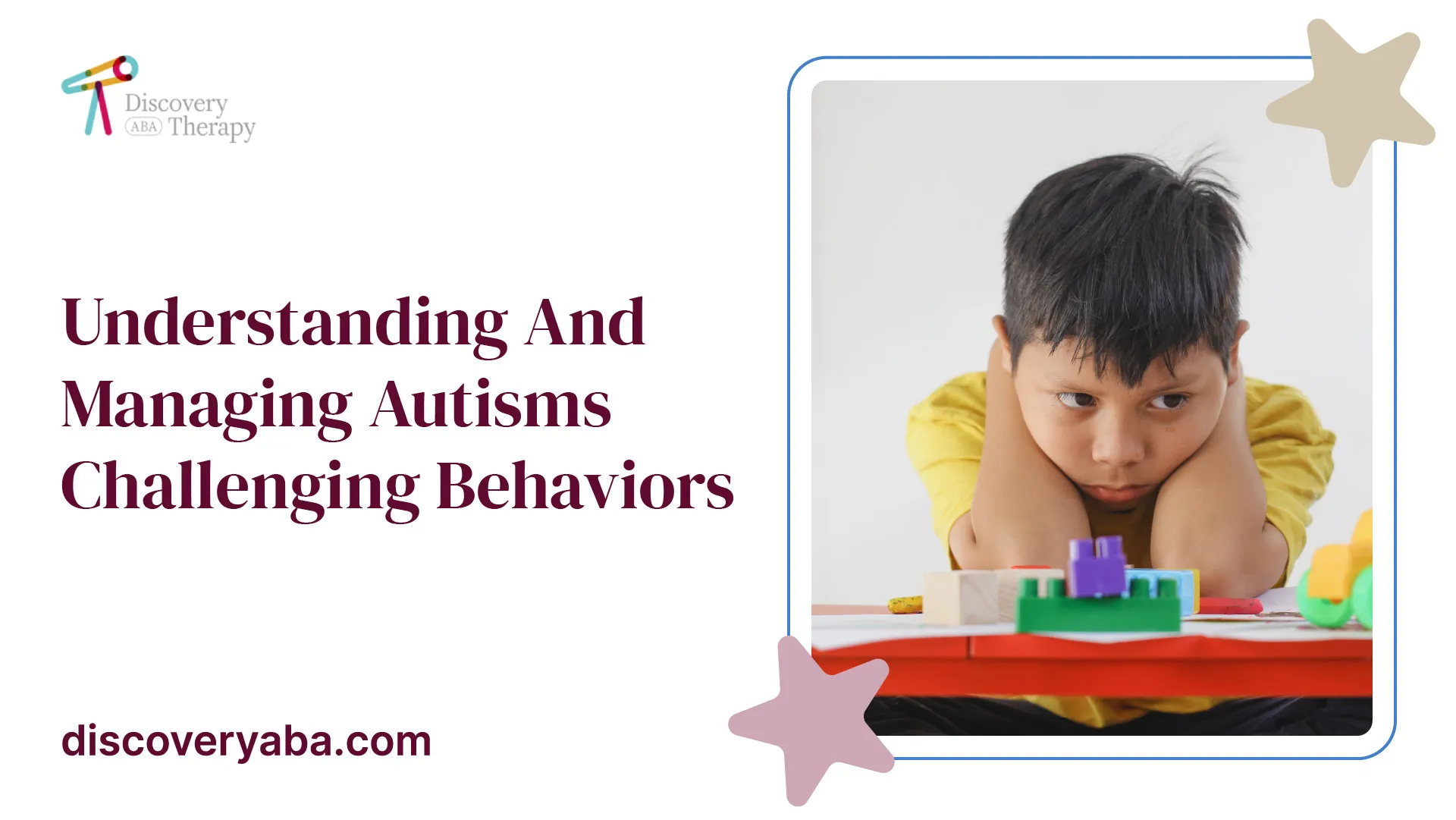Understanding and Managing Autisms Challenging Behaviors
Understanding and managing autism's challenging behaviors. Discover effective strategies and interventions for autism-related aggression.

Understanding Autism-Related Aggression
Aggression is a challenging behavior that can be observed in individuals with Autism Spectrum Disorder (ASD). Understanding the nature of aggression in individuals with ASD and identifying the risk factors associated with this behavior are important steps in effectively addressing and managing it.
Aggression in Individuals with ASD
Research indicates that aggression rates may be higher in individuals with ASD compared to those with other developmental disabilities. However, it is crucial to note that there is no evidence to suggest that individuals with ASD are more violent than those without ASD [2]. In fact, a small body of literature suggests that individuals with ASD may have an increased risk of being victims rather than perpetrators of violence [2].

Aggressive behavior in individuals with ASD can manifest in various forms, including physical aggression (e.g., hitting, biting), verbal aggression (e.g., shouting, swearing), and property destruction. These behaviors can have negative consequences for both the individuals themselves and their caregivers, leading to decreased quality of life, increased stress levels, and reduced availability of educational and social support.
Risk Factors for Aggressive Behavior
Several risk factors contribute to the occurrence of aggressive behavior in individuals with ASD. These risk factors can vary from person to person and may include:
- Adverse childhood experiences
- Sensory processing difficulties
- Communication challenges
- Cognitive impairments
- Difficulties with emotion regulation
- Co-occurring mental health conditions
It is important to note that while these factors may influence aggressive behavior, they do not cause individuals with ASD to commit extreme violent acts such as mass shootings. The vast majority of individuals with ASD are not violent. In fact, the prevalence of ASD among mass shooters is estimated to be about eight times higher compared to the general population, but it still represents a small subgroup of individuals with ASD.
Understanding the factors that contribute to aggression in individuals with ASD is crucial for developing effective strategies and interventions to address and manage this challenging behavior. By implementing appropriate therapeutic strategies, such as functional behavioral assessment, reinforcement strategies, and functional communication training, and considering pharmacological treatments, such as second-generation antipsychotics, it is possible to reduce the frequency and intensity of aggressive behavior in individuals with ASD.
Addressing Autism-Related Aggression
When it comes to addressing aggression in individuals with autism spectrum disorder (ASD), a multi-faceted approach is often necessary. This section will explore therapeutic strategies, pharmacological treatments, and early interventions that can be employed to address autism-related aggression.
Therapeutic Strategies
Therapeutic strategies play a vital role in reducing the frequency and intensity of aggressive behaviors in individuals with ASD. These strategies often include:
- Functional Behavioral Assessment (FBA): This assessment helps identify the underlying causes and triggers of aggressive behavior. By understanding the function of the behavior, appropriate interventions can be developed.
- Reinforcement Strategies: Positive reinforcement techniques are used to encourage desired behaviors, which can serve as an alternative to aggression. Providing rewards and praise for appropriate behavior can help reinforce positive choices.
- Functional Communication Training (FCT): This approach focuses on teaching individuals alternative ways to communicate their needs and desires effectively. By improving communication skills, individuals can express their feelings without resorting to aggression.
Pharmacological Treatments
Pharmacological treatments can be considered in cases where aggressive behaviors persist and significantly impact the individual's well-being. Second-generation antipsychotics have been found to be beneficial in reducing aggression in individuals with ASD. It's important to note that medication should always be prescribed and monitored by a qualified healthcare professional who specializes in ASD.
Early Interventions
Early intervention plays a crucial role in managing aggression in individuals with autism. Research indicates that early diagnosis and intervention can have significant long-term positive effects on symptoms and overall development. Early intervention programs often begin as early as 2 or 3 years old, taking advantage of the brain's plasticity during this period, which increases the likelihood of treatment effectiveness in the long term.
Early intervention programs aim to help children with autism acquire basic skills typically learned in the first 2 years of life. These programs may include a combination of therapies such as applied behavior analysis (ABA), speech therapy, occupational therapy, and social skills training. By intervening early, individuals with ASD can build essential foundational skills and learn appropriate ways to express themselves, reducing the likelihood of aggressive behaviors in the future.
Addressing aggression in individuals with autism requires a comprehensive and individualized approach. By implementing therapeutic strategies, considering pharmacological treatments when necessary, and providing early interventions, it is possible to support individuals with ASD in managing their aggression and improving their overall quality of life.
Strategies to Manage Aggression
When it comes to managing aggression in individuals with autism, implementing effective strategies is crucial for creating a safe and supportive environment. By understanding and addressing the underlying triggers, creating a calm atmosphere, and providing structure and routine, caregivers and professionals can help individuals with autism navigate challenging behaviors.
Identifying Triggers
Identifying the triggers that lead to aggressive behavior is an essential step in managing aggression. Each individual with autism may have unique triggers, and it's important to observe and document patterns of behavior to identify the specific situations or stimuli that provoke aggression. Triggers can include attempts to communicate, medical issues, sensory overload, attempts to obtain desired items, and disruptions in routine.
By understanding the triggers, caregivers and professionals can work towards minimizing or eliminating them, helping to prevent or reduce instances of aggression. This may involve making environmental modifications, providing additional support during challenging activities, and implementing strategies to help individuals cope with difficult situations.
Creating a Calm Environment
Creating a calm and soothing environment is crucial for individuals with autism who experience aggression. This can help reduce anxiety and provide a sense of security. Caregivers and professionals can create a calm environment by minimizing sensory overload, reducing noise and visual distractions, and ensuring a comfortable and safe physical space.
Using visual supports, such as visual schedules or social stories, can also help individuals with autism understand expectations and routines, reducing the likelihood of aggressive behavior. Additionally, providing opportunities for relaxation and incorporating sensory regulation techniques, such as deep pressure or sensory breaks, can contribute to a calmer environment.
Providing Structure and Routine
Individuals with autism often thrive in structured and predictable environments. Establishing a consistent daily routine can help reduce anxiety and provide a sense of stability. Consistency in routines, such as mealtimes, bedtime, and activities, can help individuals with autism feel more secure and in control.
Visual schedules and timers can be valuable tools in providing individuals with a clear understanding of their daily routines. These visual supports offer a visual representation of activities and their sequence, helping individuals anticipate and prepare for transitions.
By providing structure and routine, caregivers and professionals can help individuals with autism feel more comfortable and less overwhelmed, thus reducing the likelihood of aggression.
Implementing these strategies to manage aggression can have a significant impact on the overall well-being of individuals with autism. It is important to note that strategies may vary depending on the individual's needs and preferences. Consulting with professionals, such as behavioral therapists or healthcare providers, can provide valuable guidance and support in developing an individualized plan for managing aggression in individuals with autism.
Effective Interventions
When it comes to addressing and managing aggressive behaviors in individuals with autism, there are several effective interventions that can help improve their quality of life and reduce the occurrence of violent behaviors.
Applied Behavior Analysis (ABA)
Applied Behavior Analysis (ABA) is widely recognized as an effective method to reduce aggressive behaviors in children with autism. ABA focuses on teaching new and effective ways for individuals to communicate their wants and needs, which can ultimately decrease the occurrence of aggressive behaviors. Research has shown that ABA alone is often successful in decreasing aggression. ABA therapy is considered a gold standard for treating aggressive behaviors in children with autism, helping them learn new skills, reduce problem behaviors, and improve their quality of life.
Medications for Aggression
In certain cases, medications may be prescribed to help manage aggressive behaviors in individuals with autism. Risperidone and aripiprazole are medications approved by the U.S. Food and Drug Administration (FDA) for treating autism-related irritability, including aggression, tantrums, and self-injury. These medications have been successful in reducing aggressive behaviors in children and adults with autism. It's important to consult with a healthcare professional to determine if medication is a suitable option and to discuss potential benefits and side effects.
Combination Approaches
Recent studies have shown that a combination of interventions can be particularly effective in managing aggressive behaviors in individuals with autism. For example, a combination of parent training in behavior intervention and medication (such as risperidone) has been found to be more successful in reducing tantrums and other problematic behaviors compared to medication alone. This combination approach can be tailored to meet the specific needs of the individual and may involve a comprehensive treatment plan that includes therapy, medication, and behavioral strategies.
By utilizing a combination of effective interventions like ABA, medications, and tailored treatment plans, individuals with autism and their caregivers can work towards managing and reducing aggressive behaviors. It's important to remember that each individual is unique, and interventions should be customized to meet their specific needs. Consulting with professionals in the field of autism and behavior management can provide valuable guidance and support for individuals and their caregivers.
Impact of Aggression in Autism
Aggression is a challenging behavior commonly observed in individuals with autism spectrum disorder (ASD). It can have significant negative outcomes for both the individuals themselves and their caregivers. Understanding these impacts is crucial for developing effective interventions and support strategies.
Negative Outcomes for Individuals
Aggressive behavior in individuals with ASD is associated with several negative outcomes. These include impaired social relationships, placement in restrictive school or residential settings, and an increased risk of being victimized. Aggression can also disrupt learning in the classroom, damage relationships, physically harm the child or others, and even result in criminal charges.
Rates of aggressive behavior may vary among individuals with ASD. While some studies suggest that aggression rates are higher in individuals with ASD compared to typically developing peers and those with other developmental disabilities, the prevalence of aggression in ASD is inconsistently reported in the literature. The severity and frequency of aggressive incidents can also vary depending on factors such as age and the presence of comorbid intellectual disability.
Challenges for Caregivers
Aggression in individuals with autism can have a profound impact on their caregivers. Parents and family members often face increased stress levels, financial problems, and a lack of support services when dealing with aggressive behaviors. The presence of aggression can negatively affect day-to-day family life and overall well-being.
Caregivers may experience reduced quality of life and limited availability of educational and social support due to the demands of managing aggression in their loved ones with ASD. The distress caused by aggressive behaviors can strain relationships and create additional challenges in providing care and support.
To address the impact of aggression in autism, it is essential to develop comprehensive interventions that target the underlying causes and provide support to both individuals with ASD and their caregivers. Functional behavioral assessment, reinforcement strategies, and functional communication training have shown promise in reducing the frequency and intensity of aggressive behavior in individuals with ASD. Additionally, pharmacological treatments, particularly the use of second-generation antipsychotics, may provide some benefit in reducing aggression in individuals with ASD.
By understanding the negative outcomes associated with aggression in autism and the challenges faced by caregivers, professionals and support networks can work together to develop effective strategies and interventions to promote the well-being of individuals with ASD and their families.
Predictors of Aggressive Behavior
Factors Influencing Aggression
Aggressive behavior in individuals with Autism Spectrum Disorder (ASD) can be influenced by various factors. Specific features of ASD, such as language ability, intellectual quotient, and adaptive functioning, may predict aggressive behavior in children with ASD. It has been observed that children with ASD may engage in aggression to gain access to ritualistic or repetitive behaviors.
Additionally, rates of aggressive behavior may be higher in individuals with ASD compared to typically developing peers and those with other developmental disabilities. However, the prevalence of aggression in ASD is inconsistently reported in the literature. Some studies suggest that individuals diagnosed with intellectual disability and comorbid ASD demonstrate more frequent aggression than those with intellectual disability alone. On the other hand, some studies show that younger children with ASD demonstrate less aggression compared to a control group, but older children with ASD have higher aggression rates.
Social and Behavioral Predictors
While social factors that predict aggression in typically developing children, such as level of parent education and marital status, may not consistently predict aggression in children with ASD, there are other social and behavioral predictors to consider. Adverse childhood experiences may play a role in a small subgroup of individuals with ASD who exhibit violent offending behaviors.
Aggression in individuals with ASD has been associated with negative outcomes for both the individuals themselves and their caregivers. For children with ASD, aggressive behaviors can lead to impaired social relationships, placement in restrictive school or residential settings, and increased risk of being victimized. Furthermore, aggressive behaviors contribute to negative outcomes for caregivers, including increased stress levels, financial problems, lack of support services, and a negative impact on day-to-day family life and well-being.
Understanding the factors influencing aggression in individuals with ASD is crucial for developing effective intervention strategies and providing appropriate support. Functional behavioral assessment, reinforcement strategies, and functional communication training have shown to have a significant impact in reducing the frequency and intensity of aggressive behavior in individuals with ASD. Pharmacological treatments, particularly the use of second-generation antipsychotics, may also be beneficial in reducing aggression in individuals with ASD.
References
- https://www.ncbi.nlm.nih.gov/pmc/articles/PMC4922773/
- https://pubmed.ncbi.nlm.nih.gov/27185105/
- https://www.nichd.nih.gov/health/topics/autism/conditioninfo/treatments/early-intervention
- https://www.autismparentingmagazine.com/autism-aggression-treatment/
- https://www.autismspeaks.org/autism-and-aggression
- https://www.goldencaretherapy.com/autism-aggressive-behavior-strategies/
Does Your Child Have An Autism Diagnosis?
Learn More About How ABA Therapy Can Help
Find More Articles
Contact us
North Carolina, Tennessee, Nevada, New Jersey, Utah, Virginia
New Hampshire, Maine
Massachusetts, Indiana, Arizona, Georgia
.avif)




































































































